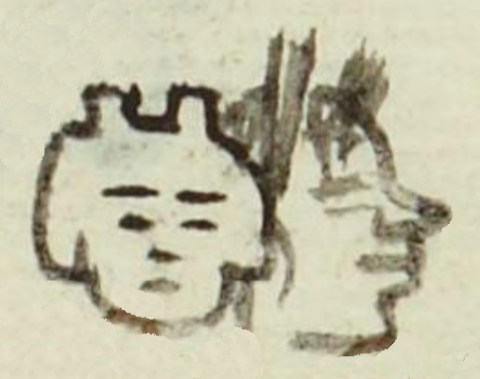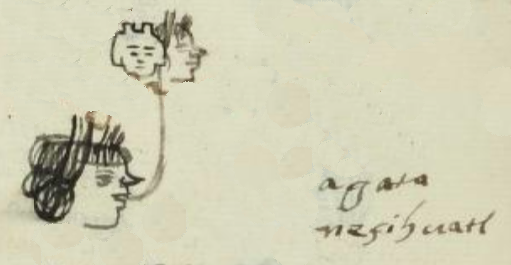Necihuatl (MH632v)
This black-line drawing of the compound glyph for the personal name Necihuatl (perhaps "Married Woman"), or possibly Nencihuatl ("Useless Woman"), is attested here as a woman's name. The compound includes the sign of nenetl (deity image, female doll, or woman's genitals), which can provide the phonetic syllable Ne- or Nen-. Here, this sign is a frontal view of a face and head. On the top of the head are two squared-off protrusions that are reminiscent of the ceramic dolls of women from an earlier time and/or some deities or supernaturals have them. The other element in the compound is the profile of a woman's head looking toward the viewer's right. Her hairstyle, the neaxtlahualli, is the diagnostic indicator that this is a woman. This involves twisted locks that are tied in such a way as to have the ends stand up on each side of the forehead.
Stephanie Wood
The woman's hairstyle could be at the foundation of the squared-off protrusions of the nenetl. Having them side by side makes it clear that the tlacuilo was well versed in the different ways of portraying nenetl and cihuatl.
1560
Jeff Haskett-Wood
women, mujeres, dolls, muñecas, efigies, effigies, imágenes, religious images, ixiptla

cihua(tl), woman, https://nahuatl.wired-humanities.org/content/cihuatl
necihuahuatiliz(tli), a man’s marriage to a woman, https://nahuatl.wired-humanities.org/content/necihuahuatiliztli
nen-, in vain, uselessly, for nothing, https://nahuatl.wired-humanities.org/content/nen
nenca, to be idle, https://nahuatl.wired-humanities.org/content/nenca
nencauh, one’s servant, https://nahuatl.wired-humanities.org/content/nencauh
nene(tl), doll, deity image, or female genitals, https://nahuatl.wired-humanities.org/content/nenetl
Mujer Inactiva (?)
Stephanie Wood
Matrícula de Huexotzinco, folio 632r, World Digital Library, https://www.loc.gov/resource/gdcwdl.wdl_15282/?sp=347st=image.
This manuscript is hosted by the Library of Congress and the World Digital Library; used here with the Creative Commons, “Attribution-NonCommercial-ShareAlike 3.0 License” (CC-BY-NC-SAq 3.0).








